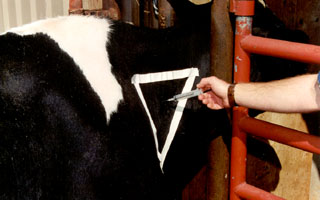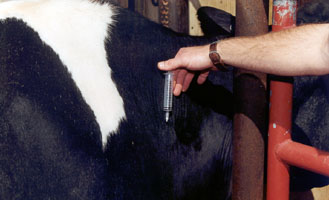
| Neck area for IM injections. |
Following are general suggestions for proper use and handling
of vaccines:Preventing disease is far less expensive than using a veterinarian to treat animals with emergency problems.
It is important that dairy producers establish a consistent herd health program to reduce the amount of infectious disease problems present in their herds. All herds are susceptible to many infectious diseases. Infectious diseases can enter a herd through purchased additions or are carried onto a farm by other animals and humans. It is important to identify what diseases are a problem in the herd or in the local area. With a veterinarian, create a strategy for protecting against and decreasing herd exposure to infectious diseases. Set up a written vaccination schedule to be followed. Modify the vaccination schedule as conditions warrant and available vaccines change. A number of new vaccines and combination vaccines have become available in recent years. A vaccination program is only one part of maintaining a healthy herd. It is advisable to develop a complete program of management, sanitation, feeding, and health care to ensure a healthy and profitable dairy operation. See page A76 for information on biosecurity.
| Advantages | Disadvantages |
|
|
| Advantages | Disadvantages |
|
|
The two most common routes to administer injections are intramuscularly (IM) and subcutaneously (SQ). A few vaccines are given orally (PO), or intranasally (IN). Giving vaccines or injections by the improper route can result in failure to immunize and may result in local reactions.
Intramuscular (IM)
Vaccines given IM are picked up by the blood supply and spread to all tissues of the body very rapidly. A needle 1 to 1 ˝ inches in length and 16 or 18 gauge in diameter is recommended for making IM injections. The best location to give injections is in the heavy muscles of the neck (see fig. 1). To reduce carcass damage, avoid the rear quarters whenever possible. It is best to give no more than 20 mL at any one site. To avoid accidental intravenous (IV) administration, pull on the plunger to make sure no blood appears in the syringe. If blood appears, pull the needle completely out and re-insert the needle in a new site.

|
Figure 1
|
Subcutaneous (SQ)
A 1-inch needle of 16 or 18 gauge diameter should be used. The loose skin on the side of the neck or behind the elbow is a good location for SQ injections. A single-handed technique of inserting the needle to give the injection is recommended (additional training may be necessary). Substances injected SQ are not picked up by the blood supply as quickly as with IM injections, but greatly reduce carcass blemishes.

|
Figure 2
|
Oral Vaccines (PO)
Oral vaccines are used to vaccinate newborn calves. First, elevate the animal’s head slightly, placing the syringe containing the vaccine at the side and back of the calf’s mouth. Next, discharge the contents of the syringe. Finally, hold the animal until all of the vaccine has been swallowed.
Intranasal (IN)
Intranasal vaccines are packaged with special applicators that fit on the end of a syringe. Restrain the cow or calf and squirt the contents quickly into the nasal passages. The animal may sneeze or cough, but this does not reduce the effectiveness of the vaccination. Never inject any intranasal product in the muscle or skin.